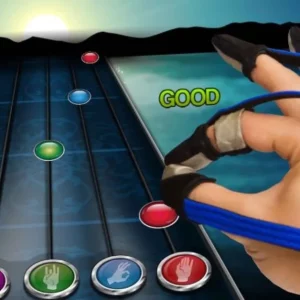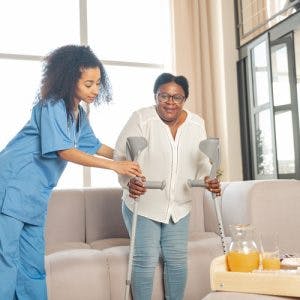Goal setting during stroke rehabilitation is crucial. This is because creating meaningful goals for yourself can provide motivation and structure on the road to recovery. Therefore, it is important to set challenging and realistic goals that push you to your highest potential.
Stroke recovery can be a lengthy and challenging process full of ups and downs. This is why the process of goal setting is so important for stroke patients as you work to stay consistent with rehabilitation. While goals for survivors often revolve around physical function, it can also be helpful to create goals for hobbies, mental health, and family.
In this article, we will review the importance of goal setting for stroke patients as well as common mistakes that are made when creating rehab goals. Then, to help you get started, we will discuss different techniques for creating meaningful, achievable goals during your recovery.
Common Mistakes When Setting Goals
Every stroke is different, which means that every recovery will be different. All stroke survivors are working with unique circumstances, and goals should be adjusted to those circumstances. Unfortunately, some survivors may lose sight of the small picture during recovery and think only about the big picture.
For instance, a person who sustained a moderate stroke and a person who experienced a massive stroke may both set a goal to walk again. Similarly, both survivors may set the goal of recovering the ability to swallow. It could be overwhelming, frustrating, or discouraging for one survivor if their road to recovery is longer than another’s.
Recovering the ability to walk or swallow are excellent goals, but they should be viewed as long-term goals. It is just as important for survivors to create smaller, short-term goals that work toward the big goal. This leads to a discussion about another common goal setting mistake: expecting an unrealistic stroke recovery timeline.
Stroke recovery is a lengthy process that generally lasts years or even a lifetime if survivors continue pursuing their goals. While many survivors will experience plateaus or even regressions in recovery at some point, we know that functional improvement is possible well into the chronic phase of stroke recovery. For this reason, it is important to remember that stroke recovery is a years-long process and will require significant patience and dedication.
The balance between challenge and appropriateness is key during stroke recovery. Therefore, it can help to review different strategies to help create goals that are personal and achievable. To help you with this, we’ll discuss tips for goal setting during stroke rehabilitation in the next section.
Goal Setting Strategies for Stroke Patients
Creating a goal-oriented rehab plan is vital for a survivor pursuing recovery after stroke. Additionally, it helps to create several different goals that work toward different aspects of recovery rather than just one singular goal. To stay motivated on the road to recovery, consider these tips for creating motivating goals after stroke:
1. Make Meaningful Goals
Survivors often struggle with consistency after they are discharged to their independent home rehabilitation program. However, consistency and repetition are key for boosting neuroplasticity, which is your brain’s natural ability to heal and recover lost functions. For this reason, it is important to create goals that are specific to your unique likes, hobbies, and lifestyle.
To give you an example, a survivor who previously enjoyed fishing may want to create a goal to bait their own fishing lure. This will give them an excellent fine motor goal to pursue as they perform occupational therapy hand exercises. Similarly, another survivor may create a goal to improve strength and balance to allow them to garden in their raised flower beds. This can motivate consistency when performing leg exercises or balance exercises prescribed by their physical therapist.
2. Start Small, Start Now
During stroke recovery, it works best to take recovery one step at a time. If a survivor is affected by hemiplegia or hemiparesis, for instance, it would be too overwhelming to set walking as the initial goal. Instead, break this big goal down into smaller steps to make it feel more attainable.
Perhaps the first goal will be to regain muscle activity in the affected limb through lower limb rehab. Once movement returns, continue to set challenging yet realistic goals, such as being able to walk with an assistive device. Then you may be able to try walking with minimal assistance from a caregiver or therapist. If walking is your ultimate long-term goal, your physical therapist will work with you to set these short-term goals based on your specific situation.
The key is to feel challenged but not overwhelmed by your goal. That way you can stay motivated to take the daily action necessary to see results. It can also be helpful to keep a goal journal and track your progress each day. This can allow you to see your improvement over time. Tracking your achievements will reassure you that you are progressing toward the goals you’ve created.
3. Work With Your Therapy Team
After stroke, your rehabilitation team will likely consist of physical therapists, occupational therapists, and speech therapists, among other professionals. These rehab experts are a fantastic resource when goal setting after stroke as they will understand your unique secondary effects and abilities.
Occupational therapists are excellent resources for setting goals specific to hand recovery or activities of daily living. Physical therapists can help you create goals for walking, endurance, strength, and even balance. Additionally, speech therapists can help you with goal setting if you are affected by dysphagia (difficulty swallowing) or speech impairments such as expressive aphasia.
Your therapists understand how to set challenging and realistic goals based on your unique circumstances. Furthermore, they are trained to incorporate your priorities into your goals. Best of all, as you progress with your goals, your therapist is there to cheer you on and set higher goals to keep you challenged. Take advantage of their expertise as you set goals during your recovery journey.
4. Seek Support
Recovering from stroke is tough. However, navigating the post-stroke journey alone is even more challenging. This is why creating your support network is such an important piece of the goal setting process. Once you’ve worked to create your own goals individually and with your therapy team, seek support from those around you to help you stay accountable.
Support can come from many places. For example, you may have close family or caregivers that can help you identify and pursue goals that are meaningful for your recovery. Your friends and your therapy team can also help provide a support network to assist you along your journey. In addition, there are stroke support groups online and possibly in your community that can understand your condition and encourage you as you recover.
5. Don’t Compare Your Journey to Someone Else’s
When setting goals during stroke recovery, there’s a balance between inspiration and competition. While finding support from other survivors is a valuable, inspiring resource, be mindful to avoid comparing their journey to yours. As we mentioned previously, every single stroke is different, and each survivor will have a unique recovery journey.
If one survivor recovered the use of their arm within 3 months after stroke, don’t allow yourself to be discouraged if you haven’t seen results after 6 months. When you are creating goals, remember that recovery is possible even decades after stroke.
Goals can always be adapted or abandoned as your situation evolves. Stroke patients should not just focus on goal setting, but also on goal adapting. For example, you may create new hobbies, have a change of living situation, or even have a large shift in physical function. Therefore, your goals should reflect these changes and evolve at the same time you do.
6. Do Your Research
After writing down your goals and scaling them down to manageable steps, ask yourself what it would take to accomplish each goal. For instance, if you want to regain speech, think about what resources can help you reach that goal. Spend time researching these resources and how they can benefit your recovery journey.
For instance, there are speech therapy apps that you can use at home to practice speech exercises. This technology can help you improve your ability to communicate with your loved ones. Similarly, if you want to regain the ability to walk, there are home exercise programs like FitMi home therapy that can motivate you and track your progress.
Research does not have to be all online. On the contrary, there are many ways to perform research to help you reach the goals you have set for your stroke recovery. Ask your therapists for recommendations or run your ideas by your therapist to make sure they’re a good fit for you. Additionally, seek inspiration from other survivors and find out what tools they used to maximize their recovery.
Goal Setting Is Just the Start
Setting meaningful, achievable goals is a great first step on the road to recovery. These goals can help provide a framework for the actions that you can take to advance your recovery. Additionally, the goals you set will help you stay encouraged and motivated to work hard toward recovering function. Spend time thinking about how you can tie your goals into your own daily life and activities to ensure they are meaningful to you.
Once you’ve created your goals, the next step is action. Seek guidance from your therapy team to create a home exercise program that allows you to work toward these goals. Then, stay consistent with your program and perform the repetitions necessary to make lasting changes. A goal means nothing unless you take action to make it happen.
Take recovery one step at a time and gather support from those around you. Goal setting for stroke patients is vital, and these goals will continue to adapt as you do. We hope this article has helped you better understand the goal setting process for stroke patients and has motivated you to continue pursuing recovery.










